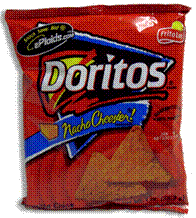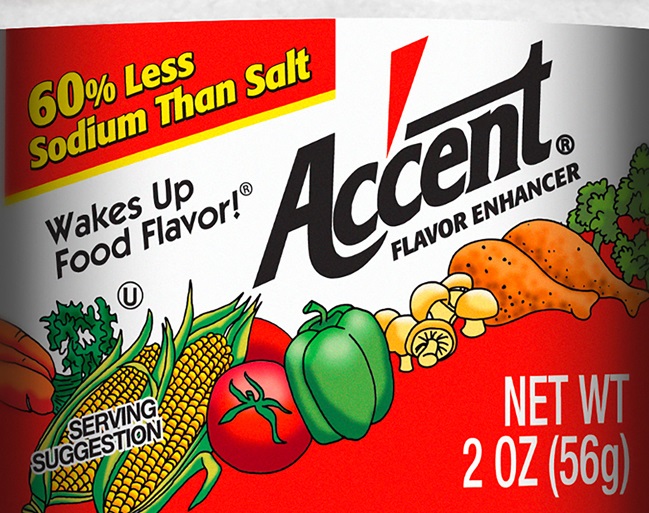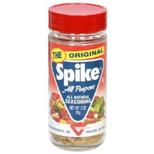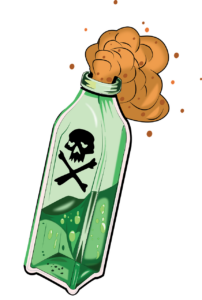MSG and other forms of neurotoxic free glutamic acid


- What is MSG (Monosodium Glutamate)?
- Why is MSG (Monosodium Glutamate) added to food?
- Excess free glutamic acid (E.g. from MSG) is an excitotoxin (can cause neurons to “Burn-out”)
- Health problems identified with MSG consumption
- Which foods / food ingredients contain MSG?
- Carageenan
- Glutamate antagonists
- Studies reporting MSG safety are slanted
MSG - Should you be concerned?
The subject of MSG on health-safety is hotly debated. With the FDA bringing down the gavel on its being safe for most people. After review of both sides of the argument, this author is convinced that we should indeed be concerned about the consumption of this free/unbound form of glutamic acid, which is not naturally consumed in high amounts. Free glutamic acid in MSG (and other forms) is now prolific in our food supply, and since it is added to food for the specific purpose of exciting neurons, it cannot so easily be found harmless in its effects on the brain. (i.e.”You can’t have your cake and eat it”). Regardless of the many controversial studies and reviews, common sense, says that if we are even minutely, artificially increasing the amount of neuronal stimulation on an ongoing basis, there are going to be health repercussions. Epidemiological studies indicate that 25-30% of the population (including this author) react to and suffer negative side-effects in varying degrees after consuming MSG, including problems such as migraine headache, seizures, asthma, depression, breathing difficulties, tingling, swelling, and paralysis. Consequently, when MSG is added to food, the FDA requires that monosodium glutamate be listed on the label or on restaurant menus to prevent a reaction by avoiding such foods. (Unfortunately, the labeling can be misleading).

What is MSG (Monosodium Glutamate)?
Monosodium Glutamate is the sodium salt of glutamic acid. GLUTAMATE, a neurotransmitter, is naturally bound to most whole, unprocessed foods (especially proteins), providing us with healthy nourishment. GLUTAMATE is converted into glutamic acid by hydrolysis. MSG was originally extracted from seaweed and other plant sources, but today, MSG is produced in many countries around the world through a fermentation process of molasses from sugar cane or beets and also starch and corn sugar.
Glutamic acid in the body. Normally, most glutamic acid is produced in the body from L-glutamine and Kreb’s cycle intermediates. Glutamic acid / GLUTAMATE functions in all cells in essential roles as a metabolic intermediate and a constituent of protein. In the brain, it is the predominant excitatory neurotransmitter, which stimulates neurons by activating GLUTAMATE receptors. Other neurotransmitters include ASPARTATE, ACETYLCHOLINE, SEROTONIN, GABA, ASPARTATE, EPINEPHRINE, NOREPINEPHRINE and DOPAMINE. Some are excitatory (GLUTAMATE and ASPARTATE) increasing electrical activity between cells, others are inhibitory (primarily GABA), and they need to be in appropriate balance with each other for proper brain function.
Free processed vs. Bound Unprocessed Glutamic Acid ? When present in its “free” form not bound together with other amino acids in protein, GLUTAMATE has a flavor enhancing effect in foods. it is the free glutamic acid in processed food, not the naturally bound form, that causes negative health reactions in many people.
Just a thought: persons who report a sensitivity to hydrolyzed proteins (containing free glutamic acid) may be sensitive to the soy, wheat or other protein source, rather than to GLUTAMATE itself.
GLUTAMATE consumed in your diet, circulates in your blood, but is regulated in the brain by the blood brain barrier (BBB). GLUTAMATE concentration in brain interstitial fluid is only a fraction of that of plasma and is maintained fairly independently of small fluctuations in plasma concentration. In most regions of the brain, the uptake of GLUTAMATE and other anionic excitatory amino acids from the circulation is limited by the BBB.
- Free glutamic acid may be more capable of crossing the BBB and increasing extracellular GLUTAMATE in the brain. This can lead to over-excitation and cell death.
- Certain conditions can cause BBB vulnerability in some people. E.g.injury, hypertension, hypoglycemia, diabetes, and dehydration. In young children, their BBB is not yet fully developed.
The average American consumes . . . About 11 grams of bound glutamate per day from natural protein sources, and 0.55 grams of free glutamic acid per day from such as MSG. National Academy of Sciences National Research Council, 1979.

Why is MSG (Monosodium Glutamate) added to food?
MSG is a neurostimulant that fools the brain into thinking that food tastes better than it really does. When added to our processed foods, FREE glutamic acid, as monosodium glutamate (MSG), hydrolyzed vegetable proteins, and about 40 other forms, masks off flavors and makes the blandest and cheapest foods taste great – mostly described as savory, meaty or broth-like. Another advantage is in encouraging the elderly to eat more as they lose their sense of taste and smell, and so prevent their typical poor nutrition status. For centuries, the Japanese have been adding Kombu to foods to enhance flavor, and in 1908, after a Japanese scientist discovered that Kombu’s active ingredient is free glutamic acid, the Japanese began use of its sodium salt MSG.
During WWII, American quartermasters found out “the secret” as to why Japanese army rations tasted so much better than the American military rations, and soon after the war, the extensive world-wide use of cheap, flavor-enhancing free glutamic acid began in the general processed-food industry.

Excess free glutamic acid (E.g. from MSG) is an excitotoxin (can cause neurons to "Burn-out")
Direct application of GLUTAMATE to the Central Nervous System (CNS) caused seizure activity. T. Hayashi, a Japanese scientist (1954);
MSG fed to newborn mice destroyed the neurons in the inner layers of the retina. Lucas, DR; Newhouse, JP (1957).
Further, MSG-induced neuron damage was found to occur throughout the rodent brain (in doses that correlate with human diets). As a result, John Olney of Washington University in 1969, coined the term excitotoxicity. He also assessed that cell death was restricted to postsynaptic neurons, that neurotoxicity occurred in proportion to the activation of GLUTAMATE receptors, and that glutamate antagonists could stop the neurotoxicity.
Olney also found, that in mice, MSG damages the hypothalamus and causes obesity, behavioral disturbances, endocrine changes, stunted bodies, seizures and infertility. The hypothalamus is a small area of the brain that controls a multitude of systems: regulating growth, the onset of puberty, most of the endocrine glands, appetite, sleeping and waking patterns, the biological clock and consciousness, and is critical for memory and learning. It is now well-known and proven that the hypothalamus atrophies as we age. Olney JW, 1969; Science Service report 1993.
Too much free glutamic acid can cause neurons to “Burn Out”. GLUTAMATE is the major excitatory neurotransmitter in the mammalian CNS, functioning appropriately to stimulate neurons (aspartate is another neurotransmitter, but stimulates to a lesser extent). However, too much GLUTAMATE can damage/destroy neurons by its excessive stimulation, in over-activating glutamate receptors (NMDA and AMPA receptors). So called excitotoxins, such as NMDA and kainic acid which bind to these receptors, and pathologically high levels of glutamate can cause excitotoxicity, by allowing high levels of calcium ions (Ca2+) to enter the cell, which:
- Activates several enzymes (E.g. phospholipases, endonucleases, and proteases
- When mitochondria absorb too much calcium, membrane pores open and may cause mitochondria to swell and release proteins that can lead to apoptosis (cell death). The opened pore can also cause mitochondria to release more calcium.
- Cellular energy ATP production may stop. ATP synthase may begin hydrolysing ATP instead of producing it. Stavrovskaya IG; Kristal BS, 2005
- GLUTAMATE builds up in the ECFF (extracellular fluid),, further activating glutamate receptors. Not only does loss off ATPP production reduce ion gradients needed to transport/remove glutamatee frommthe ECF, but even worse, the transporters reverse, causing them too releaseeGLUTAMATE ( and ASPARTATE)) intoothe ECF. This results in a buildup of GLUTAMATE and more damaging activation of GLUTAMATE receptors. Siegel GJ et al, 1999
Health problems linked to excitotoxicity
- Spinal cord injury, stroke, traumatic brain injury. This can cause the ischemic cascade, which is ischemia followed by accumulation of glutamate and aspartate in the ECF (extra cellular fluid) causing cell death.
- Neurodegenerative diseases of the CNS. E.g. M.S., Alzheimer’s disease, ALS, Parkinson’s Disease, alcoholism/alcohol withdrawal and Huntington’s disease. This author suspects MSG involvement in neuromylitis optica (NMO). Kim AH et alm 2002, Hughes JR, 2009

Health problems identified with MSG consumption
The FDA commissioned a study conducted by the Federation of American Societies for Experimental Biology (FASEB), which determined that MSG was safe for most people.
According to the FDA’s Talk Paper of August 31, 1995 – the resulting 350 page report, completed on 31 July 1995 [now deleted]:
- Reaffirms the safety of MSG. At normally consumed l evels for the general population, they found no evidence linking MSG to any serious, long-term medical problems in the general population;
- Suggests evidence that “certain people may develop short-term reactions. These included burning sensation…,facial pressure/tightness, chest pain, headache, nausea,numbness…,tingling…, bronchospasm (observedin asthmatics only), drowsiness, and weakness, when they consume large doses (approximately 3 grams or more per meal) of MSGor other free glutamates. No evidence was found linking the MSG Symptom Complex to the consumption of low levels of glutamate.”
Other findings of report. In otherwise healthy MSG-intolerant people, the MSG symptom complex tends to occur within one hour after eating 3 grams or more of MSG on an empty stomach or without other food, stating that a typical serving of glutamate-treated food contains less than 0.5 grams of MSG. A reaction is most likely if the MSG is eaten in a large quantity or in a liquid, such as a clear soup. So there’s nothing to worry about, right? WRONG . . . this is where you find out things aren’t so black and white:
- Conclusions were limited by the FDA contract. The FASEB Report responded to a set of 18 questions posed by the FDA in its contract, that virtually guaranteed that FASEB could only conclude that (a) No determination of the safety of MSG could be made without further study, or (b) That MSG was “safe.”
- 50% biased Panel. The Report was prepared with the help of an eight-man Expert Panel, consisting of at least four men with conflicts of interest.
- Data omitted and distorted. The original study was advertised as an independent review of existing literature that might pertain to the safety of MSG in food. However, some data of some independent scientists were omitted, and other data were distorted.
- Conclusions are drawn that do not necessarily follow from the data found in the body of the report.
- Questions asked limited the answers. The FDA asked: “What are the symptoms and signs of acute, temporary, and ‘self-limited’ adverse reactions…”FASEB answered the question, listing a few relatively mild reactions while ignoring the many debilitating and life-threatening reactions that have also been reported. Thus, readers are given the impression that the reactions to MSG include only a few rather benign reactions, when, indeed, that is not true.
- Gave untrue impression that there is evidence to suggest that MSG-sensitive people:
(1) Respond within one hour of exposure to MSG (but not after that time);
(2) React to an oral bolus of 3 grams of MSG or more (but not < 3 grams);
and
(3) React to 3 grams of MSG or more, only when giveninthe absence of food.
Read more on this slanted study
MSG can cause neuron death. According to Russell L. Blaylock, M.D., neurosurgeon and author of Excitoxins: The Taste that Kills, there is a link between sudden cardiac death, particularly in athletes, and excitotoxic damage caused by food additives like MSG and artificial sweeteners.Dr. Blaylock cites excitotoxins as, “A group of excitatory amino acids that can cause sensitive neurons to die.”
MSG is addictive. MSG is added to food for its flavor-enhancing and addictive effects – it causes people to eat more.
As of 2021:
- KFC has MSG in almost every chicken dish, salad dressing and gravy. That delicious secret spice on their chicken skin? – you guessed it!
- Burger King is now 100% MSG-free
- McDonald’s only uses MSG in their Crispy Chicken Sandwich
- Taco Bell has only a few menu items containing MSG
- Subway do not add MSG to menu items, but some contain ingredients having the same reactive sensitivities to MSG, such as autolyzed yeast extract and hydrolized vegetable proteins
- Chick-Fil-A classic and spicy chicken sandwiches contain MSG (or equivalent)
- Wendy’s makes it hard to find out whether or not their foods contain MSG or equivalents; Wendy’s chili contains autolyzed yeast extract.
- Sit-down places like TGIF, Chili’s, Applebee’s, and Denny’s use MSG.
MSG has been linked to obesity. Rats used in obesity experiments are purposefully injected with MSG in their suckling period to cause obesity; obesity linked with MSG consumption in Chinese study with average intakes of 0.33g MSG / day.
| Reactions to FREE glutamic acid in sensitive people | |
|---|---|
| Cardiac | Arrhythmias Extreme rise or drop in blood pressure Rapid heartbeat (tachycardia) Angina Circulatory |
| Muscular | Flu-like achiness Joint pain Stiffness |
| Neurological | Depression Dizziness / Light-headedness Loss of balance Disorientation / Mental confusion Anxiety / Panic attacks Hyperactivity Behavioral problems in children Lethargy / Sleepiness Insomnia Migraine headache Numbness or paralysis Seizures Sciatica Slurred speech |
| Gastrointestinal | Diarrhea Nausea/vomiting Stomach cramps Irritable bowel Bloating |
| Respiratory | Asthma, Shortness of breath Chest pain / Tightness Runny nose / Sneezing |
| Skin | Hives or rash Mouth lesions / Extreme dryness of the mouth Temporary tightness or partial paralysis (numbness or tingling) of the skin Flushing |
| Urological | Swelling of prostate Nocturia |
| Eyes | Visual Blurred vision Difficulty focusing |
MSG-induced reactions can be delayed as much as 48 hours or can occur immediately after ingestion or exposure

Which foods / food ingredients contain MSG?
Many food products are illegally misbranded with “No MSG Added”. A food label that declares such is false and misleading under section 403 (a)(1) of the Federal Food, Drug, and Cosmetic Act when the label also lists any other ingredient that does contain MSG, such as hydrolyzed protein, maltodextrin or modified food starch.
The amount of MSG is relevant. The amount of processed free glutamic acid in a product or produced in the body after consumption, determines whether or not you might suffer an MSG reaction.
Avoiding MSG basically requires that you do not eat out at restaurants.
| Foods Typically containing MSG | ||
|---|---|---|
| Bacon bits | Baking mixes | Bouillon cubes |
| Bread Stuffing | Canned Meats | Cheese Dips |
| Corn chips | Croutons | Dry roasted peanuts |
| Fried Snack Foods | Frozen breaded fish | Frozen dinners |
| Frozen Pizza | Gelatins | Pasta sauces |
| Potato chips | Processed meats | Relishes |
| Salad dressings | Salt substitutes | Potato Chips E.g. Doritos®, Cheetos® |
| Seasonings* | Canned Soups, broths | Soy Sauce |
| Some processed cheeses | Hot chocolate | Items with added cheese powder |

* Accent® is PURE MSG
*Spike® – contains high flavor yeast, hydrolyzed vegetable protein, both forms of MSG;

Some snack foods that do NOT contain MSG:
- Blue Almonds spicy flavors. e.g. Jalapeno Smokehouse and Wasabi flavor;
- Cheez-It snack crackers (original flavor). However, some new variations of Cheez-It crackers contain MSG;
- Wal-Mart Great Value BBQ flavored Potato Chips
Food packagers try to disguise the presence of MSG (free glutamic acid) in their products by using other names, not so familiar to the general public:
| These ALWAYS contain MSG | ||
|---|---|---|
| Glutamate (E 620) | Glutamic acid (E 620) | Monosodium glutamate (E 621) |
| Monopotassium glutamate (E 622) | Calcium glutamate (E 623) | Monoammonium glutamate (E 624) |
| Magnesium glutamate (E 625) | Natrium glutamate | Gelatin |
| Calcium caseinate | Sodium caseinate | Textured protein |
| Anything “hydrolyzed” | Any “hydrolyzed … protein” | Yeast nutrient |
| Yeast extract | Yeast food | Autolyzed yeast |
| Vetsin (Phillipines) | Ajinomoto (Japan)アミノ酸 | Plant protein extract |
| Phong churot (Thailand) | Wie jing (China) | Umami (USA) |
| These OFTEN contain hidden MSG or create MSG during processing | ||
|---|---|---|
| Carrageenan | Maltodextrin | Malt extract |
| Natural pork flavoring | Citric acid | Malt flavoring |
| Bouillon and Broth | Natural chicken flavoring | Soy protein isolate |
| Natural beef flavoring | Ultra-pasteurized | Soy sauce |
| Stock | Barley malt | Soy sauce extract |
| Whey protein concentrate | Pectin | Soy protein |
| Whey protein | Protease | Soy protein concentrate |
| Whey protein isolate | Protease enzymes** | Anything protein fortified |
| Flavors(s) & Flavoring(s) | Anything enzyme modified | Anything fermented |
| Natural flavor(s) & flavoring(s) | Enzymes anything | Seasonings / Spices (the word “seasonings”) |
**Protease enzymes of various sources can release excitotoxin amino acids from food proteins
These ingredients work synergistically with MSG to enhance flavor (If they are present for flavoring)
| Disodium 5′-guanylate (E 627) | Disodium 5′-inosinate (E 631) | Disodium 5′-ribonucleotides (E 635) |

Carageenan
Carrageenan is used as a binding agent, thickener, stabilizer, and texturizer. A rather new additive, it is a complex polysaccharide extract made from seaweed.
Carrageenan contains free glutamic acid or creates it during processing. A thickening agent (similar to agar); used in chocolate processing, toothpaste, ice cream, sour cream, cherry pies, some soy milk (e.g. SILK, EdenSoy),almond milk, cheeses and dairy foods,prescription pills.
There are two types of carrageenan:
- Undegraded carrageenan (food grade). This has been used on a huge scale in food production worldwide since the 1930s – and its safety has been assured by the FDA Gras status. The Joint Expert Committee on Food Additives (JECFA) of the United Nations’ Food and Agricultural Organization (FAO) and the World Health Organization (WHO) gave carrageenan the highest ADI (Accepted Daily Intake) status of ‘not specified’.
- Chemically treated, degraded carrageenan (hydrolyzed with acid). This is a known carcinogen (cancer causing agent) and is not used or permitted in food production – but is frequently used to experimentally induce intestinal inflammation and to promote tumors in animal studies.
http://www.edenfoods.com/articles/view.php?articles_id=82
The following review found that even UNDEGRADED carageenan can cause harmful effects in GI tract:
Abstract – In this article I review the association between exposure to carrageenan and the occurrence of colonic ulcerations and gastrointestinal neoplasms in animal models.
Although the International Agency for Research on Cancer in 1982 identified sufficient evidence for the carcinogenicity of degraded carrageenan in animals to regard it as posing a carcinogenic risk to humans, carrageenan is still used widely as a thickener, stabilizer, and texturizer in a variety of processed foods prevalent in the Western diet.
I reviewed experimental data pertaining to carrageenan’s effects with particular attentionto the occurrence of ulcerations and neoplasms in association with exposure to carrageenan. In addition, I reviewed from established sources mechanisms for production of degraded carrageenan from undegraded or native carrageenan and data with regard to carrageenan intake.
This association may be attributed to contamination of undegraded carrageenan by components of low molecular weight, spontaneous metabolism of undegraded carrageenan by acid hydrolysis under conditions of normal digestion, or the interactions with intestinal bacteria. Although in 1972, the U.S.Food and Drug Administration considered restricting dietary carrageenan to an average molecular weight > 100,000, this resolution did not prevail, and no subsequent regulation has restricted use. Because of the acknowledged carcinogenic properties of degraded carrageenan in animal models and the cancer-promoting effects of undegraded carrageenan in experimental models, the widespread use of carrageenan in the Western diet should be reconsidered. Joanne K. Tobacman, 2001

Glutamate antagonists
Opposing glutamate action can be approached from at least 3 directions:
(1) Activate GABA receptors. E.g. anti-anxiety medications such as Xanax, Valium and Klonopin(cause drowsiness and can lead to dependence),
(2) Provide medications/substances antagonistic to glutamate. Ginkgo Biloba Extract is purported to be a powerful glutamate antagonist.
(3) Provide medications/substances antagonistic to glutamate’s receptor N-methyl-d-aspartate (NMDA). By binding with these receptors, the antagonist medication reduces glutamate-induced continuous firing of the neuron. E.g. Memantine is an NMDA antagonist (also hallucinogenic) used for Alzheimer patients;
Natural substances purported to protect against excess glutamate in the brain. L-Theanine, Magnesium, NAC, ALA, Resveratol, B6, CoQ10. (Note: This website author has not researched these)

Studies reporting MSG safety are slanted

Example Study: Glutamate Safety in the Food Supply
The following is included for those who are interested in seeing how biased parties have slanted study results claiming the safety of MSG.
E.g. Studies such as this one, funded by International Glutamate Technical Committee finds MSG concerns to be unwarranted.
Studies that seemingly debunk the health concerns over MSG have used several ploys as follows:
Although it had been established that brain lesions could not be identified if examination was not done within 24 hours after insult, glutamate-industry researchers routinely examined the brains of test animals after 24 hours had elapsed.
Monkeys are much less sensitive to glutamate than humans. Mice and rats have reactions closer to ours. According to Dr. John Olney, “The same oral dose of glutamate that causes a dramatic increase in blood glutamate concentrations in humans, causes no increase at all in monkeys. Therefore, it is difficult to understand why so much money and effort was expended on oral glutamate monkey studies, unless the goal was to amass negative evidence that could serve as basis for fostering the misleading impression, and fueling the spurious argument that if monkeys are resistant to glutamate-induced brain damage, other primates, including humans, must be similarly resistant.”
In studies with people, glutamate industry researchers have sometimes used aspartame (Nutrasweet®) as the “placebo” for their “control” groups. Aspartame contains aspartic acid, which is a structural analog of glutamic acid and causes the same toxic effects. Thus, they could be confident that they would get the same effects in the experimental and in the “control” groups.
Populations chosen for studies by glutamate industry researchers were pretestedwith placebos containing, for example, aspartame, carageenan, or enzymes to which MSG-sensitive people would react. In this way, by choosing study participants, who do not react to the so-called “placebos”, the scientists could be pretty sure that their subjects would not react to MSG.
Another way to reduce reactions is to put the MSG in capsules, such that it will be slowly released and reactions of MSG-sensitive people will be blunted compared to their reactions to the same amount of MSG sprinkled on food.
Giving MSG with sucrose will also blunt reactions. Dr. Blaylock has explained that a tremendous amount of energy is required for the brain to manage glutamic acid and, of course, glucose is what our brains use for energy.
To defend themselves against epidemiological studies indicating that 25-30 per cent of the population reacted to monosodium glutamate and against individual reports of human adverse reactions that included migraine headache, seizures, asthma, and depression, the glutamate industry built the fiction that a few people might react to monosodium glutamate with the “Chinese restaurant syndrome”: “burning,” “tightness,” and “numbness,” all occurring at the same time, within two hours following ingestion. They sent out a questionnaire and got 3,222 respondents, of whom 1.8 % reported having the exactly defined “Chinese restaurant syndrome.” The fact that an additional 41.2 % of the subjects reported experiencing conditions that are associated with MSG-induced adverse reactions such as headache, diarrhea, chest pain, dizziness, palpitation, weakness, nausea/vomiting, abdominal cramps, chills, heartburn, unusual thirst, unusual perspiration, flushing sensation in face or chest, and tingling was ignored. Migraine headache, seizures, tachycardia, hives, skin rash, and depression, which were not offered as options, were not considered.
Soon the FDA (U.S. Food and Drug Administration) began to disseminate the misinformation that less than 2% of the population might be sensitive to MSG, reacting with the mild and transitory reactions of “Chinese restaurant syndrome.”
The FDA says that MSG is “SAFE” – Anyone who reads the entire FASEB report knows it isn’t
The following article from “Truth in Labeling Campaign” exposes the misleading results of the FDA-commissioned FASEB report on MSG Safety, pointing out that:
“Addressing the Report, addresses the larger issues of personal and corporate greed, lack of scientific integrity, and man’s inhumanity to man. To hide a neurotoxic and potentially debilitating and/or life-threatening additive in food, is immoral.”
References
http://www.advancedhealthplan.com/msgstudy.html
IFIC Review on Monosodium Glutamate: Examining the Myths- http://extoxnet.orst.edu/faqs/additive/ificmsg.htm
Hughes JR (February 2009). “Alcohol withdrawal seizures”. Epilepsy Behav 15 (2): 92-7. doi:10.1016/j.yebeh.2009.02.037. PMID 19249388.
Joanne K. Tobacman (2001) Review of Harmful Gastrointestinal Effects of Carrageenan in Animal Experiments. College of Medicine, University of Iowa, Iowa City, Iowa, USA. Environ Health Perspect 109:983-994. [Online 24 September 2001]
Kim AH, Kerchner GA, and Choi DW. Blocking Excitotoxicity. Chapter 1 in CNS Neuroprotection. Marcoux FW and Choi DW, editors. Springer, New York. 2002. Pages 3-36.
Lucas, DR; Newhouse, JP (1957). “The toxic effect of sodium L-glutamate on the inner layers of the retina.”. A.M.A. Archives of ophthalmology 58 (2): 193-201. PMID 13443577.
National Academy of Sciences National Research Council. The 1977 Survey of the Industry on the Use of Food Additives: Estimates of Daily Intake. Vol. 3, Washington, D.C.: National Academy Press, 1979.
Olney, JW (1969). “Brain lesions, obesity, and other disturbances in mice treated with monosodium glutamate.”. Science 164 (880): 719-21. PMID 5778021.
Science Service report 1993. Ref: Studies by James Golomb of New York University, using MRI on patients 55 to 87, on the results of atrophy of the hypothalamus, memory and learning.
Siegel, G J, Agranoff, BW, Albers RW, Fisher SK, Uhler MD, editors. Basic Neurochemistry: Molecular, Cellular, and Medical Aspects6th ed. Philadelphia: Lippincott, Williams & Wilkins. 1999.
Stavrovskaya, IG; Kristal, BS (2005). “The powerhouse takes control of the cell: is the mitochondrial permeability transition a viable therapeutic target against neuronal dysfunction and death?”. Free radical biology & medicine 38 (6): 687-97. doi:10.1016/j.freeradbiomed.2004.11.032. PMID 15721979.



















